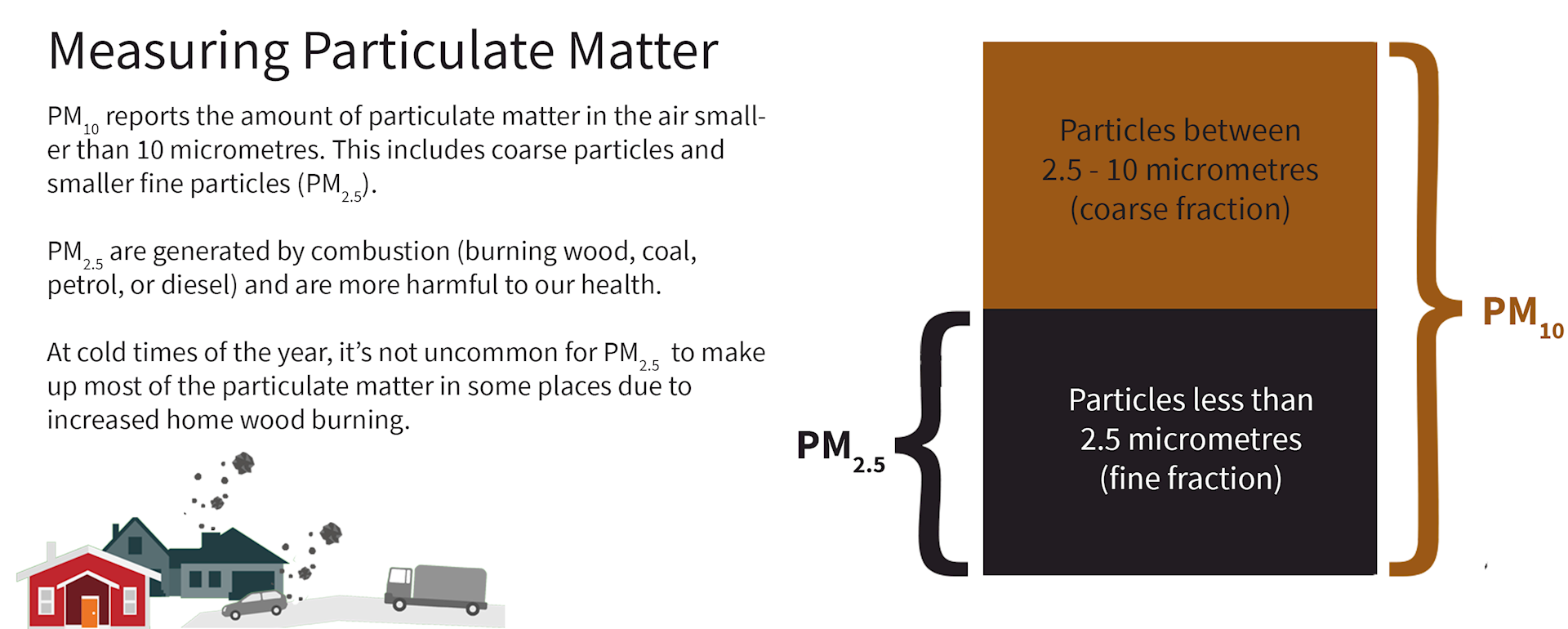Particulate matter (PM) are small airborne particles composed of solid and/or liquid matter. These airborne particles are less than 10 micrometres in diameter (about a fifth of the thickness of a human hair). These include fine particles (less than 2.5 micrometres) – known as PM2.5, and coarse particles (between 2.5 and 10 micrometres) – together fine and coarse particles are known as PM10.
PM2.5 and PM10 are pollutants that are most commonly caused by the combustion of wood and fossil fuels such as home heating and traffic. Other natural sources include dust, pollen and sea spray.
These airborne particles are small enough to be breathed in and penetrate into the human lung. This can cause negative health effects for people’s respiratory and cardiovascular systems.
Airborne particles
Airborne particles are generated by human activities and arise from natural sources. Common activities that lead to particles being released into our air include burning wood for home heating, vehicle exhausts (particularly diesel), road dust, and quarrying. Natural sources include sea salt, pollen, and wind-blown soil particles including liquefaction dust.
Collectively, all airborne particles are called particulate matter (PM). To enable us to compare measurements, better understand health impacts, and manage the levels of PM in air, we commonly classify particles by their size:
- PM10 particles are smaller than 10 micrometres (µm) across
- PM2.5 particles are smaller than 2.5 micrometres (µm) across
The diagram below compares the size of PM10 and PM2.5 particles to a strand of hair and a grain of fine beach sand. They are tiny – too small for the human eye to see. Note that PM10 includes the smaller PM2.5 particles.

Potential health impacts
The size of particles is also important for health impacts. Generally, the larger sized particles (between 2.5 µm and 10 µm) when breathed in remain in the upper airways. Whereas smaller particles (PM2.5 and smaller) can lodge deeply in the lungs and even enter the bloodstream. PM2.5 particles are typically produced by human activities, such as burning of wood and fossil fuels.
In the short term, PM10 mainly affects people’s lungs and heart, ranging from reduced lung function, impaired activities (e.g. sick days off school or work), more doctors’ visits and hospital visits. Long term effects are reduced life expectancy. Large studies overseas that have looked at impacts of PM10 on population health have not been able to reliably identify a level of PM10 in air below which there are no adverse health effects. In New Zealand, most regional councils and unitary authorities measure PM10 and an increasing number also carry out PM2.5 monitoring.

PM10
PM10 include fine and coarse airborne particles less than 10 micrometres across (about the fifth of the thickness of a human hair). They are produced by the combustion of wood and fossil fuels, as well as by various industrial and natural processes. These concentrations are measured in micrograms per cubic metre (µg/m3) of air.
These particles can easily be breathed in. When the largest particles are inhaled, they get trapped in the nose and nasal passages and can cause irritation. The smaller particles (PM2.5, less than 2.5 micrometres across, and included in PM10 measurements), can enter our lungs and also reach the bloodstream, potentially leading to respiratory diseases, heart attacks, and lung cancer.
PM2.5
PM2.5 are fine airborne particles less than 2.5 micrometres across (these are a component of PM10). They can be easily breathed deep into the lungs where the smallest particles can enter the bloodstream. These concentrations are also reported in micrograms per cubic metre (µg/m3) of air.
Health effects include respiratory diseases, heart attacks, and lung cancer. Most particulate matter from natural sources is larger than 2.5 micrometres across.

Where can I find more information?
Check with your regional council or unitary authority for more information on air quality monitoring in your area.
